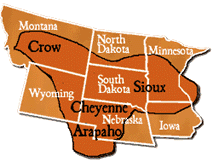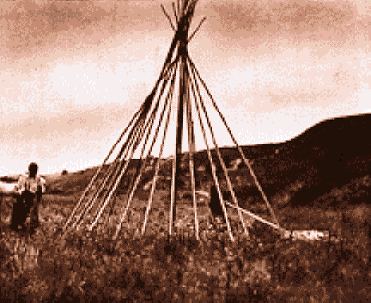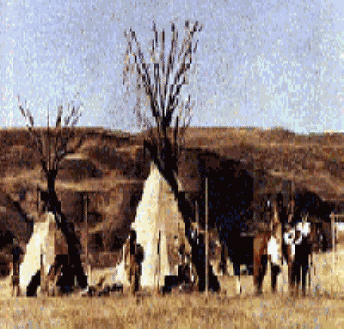|
 |
Left: Sioux Indian Boundary Map |
|
|
Their Appearance:
The Sioux wore their hair, traditionally, long and braided and were very
tall. The women made all the clothing. The men wore
leggings, loin clothes (breech cloth), and moccasins. It was
customary
not to wear shirts unless they had to. The women wore deerskin
dresses reaching halfway below the knee, elbow length sleeves (open at
the armpits), leggings extending from ankle to knee, and
moccasins. Almost everything was decorated with fringes, quills, or
beads. All clothing was made from skins, mostly deer, but
some elk and antelope. For winter, the Sioux wore buffalo robes,
fur side under, and moccasins lined with fur, plus the clothing listed
above. During special ceremonies, the women wore dresses
decorated with elk teeth, bear claws, and feathers. |
|
| The Food:
The Indians ate almost anything they could find. As their main
staple the ate buffalo meat the most. They also ate bear,
antelope, turkeys, and hens as other sources of meat. They picked
wild fruits such as cherries, berries, and plums. As vegetables
they had potatoes , spinach, and prairie turnip. They also caught
fish in nearby streams and rivers. The Sioux rarely went hungry. |
|
| The Dwelling:
A Sioux Indian lived in a teepee.
It was made from tall wooden poles covered with buffalo hide. It had a hole at the top with folds going out.
The hole was there to let the smoke get out in the summer and to
keep the smoke in in the winter. The teepee only took a few minutes to take apart and put
back together, making it easier to travel with.
They slept on buffalo robes on the left side of the door; the
right side was for company and supplies.
The fireplace was in the middle of the teepee. |

|
|
|
The Children:
The
children were called "Wakanisha".
"Waka"
means sacredness. They were the center of attention, the primary
importance. When a baby was
born, the parents would choose second parents (guardians). The child would spend just as much time with the second
parents as with his/her real parents, teaching the child all they knew.
The baby would not be allowed to cry.
If he/she cried the mother would pinch his/her nose and put her
hand over his/her mouth. This
way, he/she would learn not to cry out loud.
When he/she was old enough, he/she would help with most of the
work. The children of the
Sioux would learn to swim before they learned to walk.
They would find out things by finding out for themselves.
They mostly learned as they played.
The best warriors and hunters taught the boys.
By the age of five, both boys and girls could hunt small animals
with a bow and arrow and the boys were good riders.
At the age of seven, the boys could take care of the family’s
horses. Contests were held to see how much the boys of the tribe had
learned. The most skilled
boys were picked to ride with the scouts or to run errands during
battle. By the age of ten,
boys were expected to hunt and kill their first buffalo calf.
If they did there would be a great feast, but he would not be
allowed to eat any of the buffalo meat.
It was to teach him that it was wrong to want things for himself.
|
|
|
Becoming Grownup:
Boys: When a boy turned 12,
it was time for him to seek the spirit that would protect him until he
died. He would see the
spirit in a dream (vision) and from signs.
The boy was taken far away from the camp to spend four days and
four nights by himself. He
could not drink or eat during this period.
He prayed to the spirits to send signs.
He had to remember what he saw in his dreams.
When some men came to get him, he was very weak.
Then he was taken to the medicine man (holy man) and he told the
holy man everything that he had heard, seen, and felt in his
dreams. The medicine man would then decide what the boy’s spirit
was. Pictures of the spirit
would be painted on his teepee and shield.
Then there was a great feast.
The boy was now a man.
Girls: Before a girl was
old enough to marry, she had to make and repair clothes and tepees,
cook, care for babies, paint designs, decorate with quills and beads,
and, most importantly, know what her spirit was.
She would see it in a vision.
Not like the boys, she would stay in a teepee, close to the
tribe, with an old woman for four days and four nights.
She could also eat and drink a little.
The girl would have to pray and work hard. She had to make skins, sew, cook, and chop wood.
Then the old woman would take her to the medicine man, who would
tell her what her spirit was. Then the women of the tribe would bathe the girl and dress
her in fine new clothes. Then
there was a feast in which the girl would get presents for becoming a
woman.
|
|
|
 |
To Get Married:
A
young man had to have many horses and honors to marry.
You could tell which man liked which woman.
He would be everywhere the young woman was!
At night, the young man stood outside the woman’s teepee for
hours. There could be more than one man standing outside her teepee.
If the young man thought he had a chance he would play songs to
her on his flute. If he thought the young woman liked him, he would bring one
of his horses to her family.
If the family accepted the horses, than that means the young
woman wants to marry him. The
man could not ask the woman himself.
He had to have an older man or woman ask for him.
If the woman accepted the young man, he had to give the family a
lot more horses. When they
married, they had to live near or in the wife’s parent’s teepee.
Always, an older person would live with them, to give advice and
to help with work. This
way, no one went without a home. If
a man was rich, he could have more than one wife, usually the first
wife’s sister or cousin.
|
|
|
Religion:
In
the Sioux religion, everything had a life of its own, or its own spirit.
The Earth was the mother of all spirits.
There was a spirit for all four directions and many more, but the
spirit with the greatest power was Wakon Tanka meaning “Great
Spirit”. The reason was
because it sent the buffalo. If dreams and signs came to you from the spirits, it was good
luck and it would keep sickness away.
Everyday, the Indians worshipped.
They prayed, sang, danced, and gave gifts, either alone or with
the tribe. There were five
principle religious rites: Vision
Cry, Ghost Dance, Buffalo Chant, Foster Parent Chant, and
most famous, the Sun Dance.
Every year before the big buffalo hunt, it took place.
It was a 12 day summer ritual of self-sacrifice, testimony of
individual courage, and endurance in serving the Great Spirit.
They would ask the spirits to bring lots of buffalo.
The reason for some men to torture themselves was that they
believed it would please the spirits.
Everything they did was to please the spirits. |
|
|
|
“Men did a shuffling side step in place with one hand held up feather
skirt in rear; the other arm flexed upward.
They reversed the arm position in time to the side shuffle.
The men entered on their hands and knees.
When the song changed, they arose and did the shuffling step in
place. The women held grass
whisks in each hand, and flexed their arms up and down alternatively.
-A
quote about the Sun Dance |
|
|
|
The Medicine Bundle and
Weapons:
The medicine bundle was used to keep danger away.
The medicine man told the people what to put in it to please the
spirits. If a man was
having good luck, you could ask to borrow his medicine bag for awhile. The shield had special powers, and could not touch the
ground. The man’s spirit
was usually painted on it. It
hanged outside of his teepee. Every
man had a spear, club, and a bow and arrow.
Every arrow had a special mark or paint on it to tell which arrow
belonged to which man.
|
|
|
|
The Buffalo Hunt:
The Sioux Indians were nomads, which meant they followed the
buffalo.
The buffalo hunt was taken very seriously and was well planned.
The Chief would chose leaders and scouts for the hunt.
It might take weeks before the scouts found the buffalo.
Then the camp would move. The
women were in charge of moving everything.
The supplies were put on travois and were pulled by horses.
The Takola, a group of Indian men, were in charge of keeping
order on the trip. On the day of the actual hunt, every hunter took
part. No one was allowed to kill more buffalo than the tribe could
use. While the hunters were
gone, the camp was worshipping, trading, and visiting other tribes.
When the hunters came back the women followed them.
The men would help the women to skin, cut the meat, and load it
on horses. Then there was a great feast, thanking the spirits for the
buffalo that were killed. |

In Pursuit of the White Buffalo
Artist: Frank McCarthy |
|
|
|
Uses of the Buffalo:
Every part of the buffalo was used.
Nothing was wasted. Here
are some examples of what each part was used for.
Bones: toys, awls, painting
sticks
Muscles: thread
Horns: spoons, cups
Stomach: pots
Tongue: saved for special
religious celebrations
Droppings: fuel
Hair: ropes, belts, decorations
Ribs: sleds
Hide: makes hard leather,
rawhide, which was made into drums, rattlers, bags, glue, splints.
Makes tanning hide which was made into bags, moccasins,
clothing, pipe holder, teepee cover
|
|
|
|
|
|
|
|
Medicine and Death:
When someone got sick, the people of the tribe used plants called
herbs to make medicines. If
the medicines didn’t work a Shaman was called upon.
A Shaman had special power.
He sang songs, prayed, and danced to the spirits.
If a child got sick and if nothing worked the Shaman could change
the name of the child, which actually worked sometimes.
If someone died, the people in the tribe would not hide their
sorrow. They would go
through a ceremony called Wacekiyapi (Spirit Keeping Ceremony).
It was a four-day period where the family and the tribe would
mourn for the death of someone. They
cut their skin until they bled. They
cried and sobbed in public. It
was bad manners to ever say the name of the dead person.
After someone died, it was thought that they lived with the
spirits forever and continued to keep doing the same things they did on
Earth. |
|
|
|
Chiefs:
The title Chief was a medal earned for outstanding performances
during war and peace. But
he was not solely “in charge” of the people.
The rules were voted by a unanimous vote of a council of Chiefs
or “Headmen” from all the main bands.
Only boys could become chiefs, and you had to be brave and generous.
You could be eligible to Chieftainship if you had gotten a first
honor. Not only did the
Chief council make the rules, they also made the punishments. |
|
|
|
Punishments:
If you broke a tribal rule there could be severe, punishments.
The tribe might burn your teepee and all of your belongings.
Or the ultimate punishment, making you leave the tribe. The punishment for lying was being laughed at. |
|
|
|
|
|
To the Sioux Indians no one owned the land, but the Whites thought
different. When the Whites
came they brought sickness and death.
Thousands of Sioux went hungry when the Whites killed all most
all of the buffalo, and took the land.
Only about 40,000 Sioux Indians live in the North and South
Dakotas today. |
|
|
|
“There was a time when the land was sacred, and the ancient one were
as one with it. A time when
only the children of the Great Spirit were here to light their fires in
these places with no boundaries. In
that time, when there were only simple ways, I saw with my heart the
conflicts to come, and whether it was to be for good or bad, what was
certain was that there would be change.”
-The
Great Spirit |




